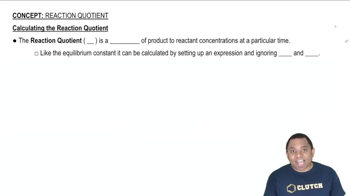Here are the essential concepts you must grasp in order to answer the question correctly.
Chemical Equilibrium
Chemical equilibrium occurs when the rates of the forward and reverse reactions are equal, resulting in constant concentrations of reactants and products. At equilibrium, the system is dynamic, meaning that reactions continue to occur, but there is no net change in the concentrations. Understanding this concept is crucial for analyzing the extent to which a reaction proceeds and the conditions under which it reaches equilibrium.
Recommended video:
Chemical Equilibrium Concepts
Equilibrium Constant (Kc)
The equilibrium constant (Kc) is a numerical value that expresses the ratio of the concentrations of products to reactants at equilibrium, each raised to the power of their coefficients in the balanced equation. A large Kc value, such as 4 * 10^45, indicates that at equilibrium, the concentration of products is much greater than that of reactants, suggesting that the reaction favors product formation. This concept helps predict the direction and extent of a reaction.
Recommended video:
Equilibrium Constant Expressions
Reaction Quotient (Q)
The reaction quotient (Q) is a measure of the relative concentrations of reactants and products at any point in time, not just at equilibrium. By comparing Q to Kc, one can determine the direction in which a reaction will proceed to reach equilibrium. If Q < Kc, the reaction will shift to the right to produce more products; if Q > Kc, it will shift to the left to produce more reactants. This concept is essential for understanding how changes in conditions affect the position of equilibrium.
Recommended video:
 Verified step by step guidance
Verified step by step guidance


